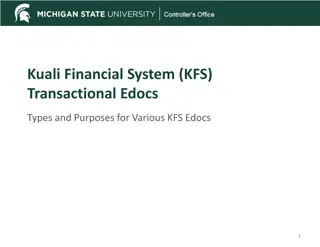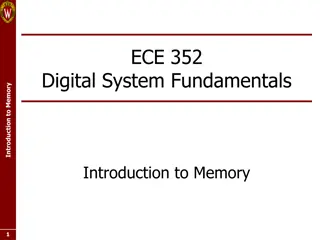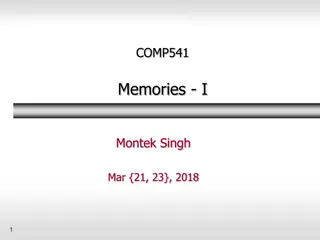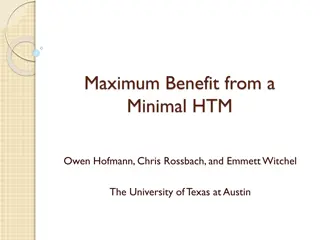Transactional Memory Performance Exploration
This study delves into transactional memory performance, comparing it with traditional locking mechanisms. It discusses the challenges, benefits, and trade-offs associated with transactional memory in multicore systems. The research aims to develop a performance model and tools for optimizing transactional memory systems to enhance concurrency and scalability.
Download Presentation

Please find below an Image/Link to download the presentation.
The content on the website is provided AS IS for your information and personal use only. It may not be sold, licensed, or shared on other websites without obtaining consent from the author.If you encounter any issues during the download, it is possible that the publisher has removed the file from their server.
You are allowed to download the files provided on this website for personal or commercial use, subject to the condition that they are used lawfully. All files are the property of their respective owners.
The content on the website is provided AS IS for your information and personal use only. It may not be sold, licensed, or shared on other websites without obtaining consent from the author.
E N D
Presentation Transcript
1 UNDERSTANDING TRANSACTIONAL MEMORY PERFORMANCE Donald E. Porter and Emmett Witchel The University of Texas at Austin
Multicore is here 2 Lenovo ThinkPad T400 7417 - Core 2 Duo 2.4 GHz - 14.1 " - 2 GB Ram - This laptop 2 Intel cores Intel Single-chip Cloud Computer 48 cores Tilera Tile GX 100 cores Only concurrent applications will perform better on new hardware
Concurrent programming is hard 3 Locks are the state of the art Correctness problems: deadlock, priority inversion, etc. Scaling performance requires more complexity Transactional memory makes correctness easy Trade correctness problems for performance problems Key challenge: performance tuning transactions This work: Develops a TM performance model and tool Systems integration challenges for TM
Simple microbenchmark 4 lock(); if(rand() < threshold) shared_var = new_value; unlock(); xbegin(); if(rand() < threshold) shared_var = new_value; xend(); Intuition: Transactions execute optimistically TM should scale at low contention threshold Locks always execute serially
Ideal TM performance 5 3 xbegin(); if(rand() < threshold) shared_var = new_value; xend(); 2.5 Execution Time (s) 2 1.5 Performance win at low contention 1 Locks 32 CPUs Ideal TM 32 CPUs 0.5 0 Higher contention degrades gracefully 100 10 20 30 40 50 60 70 80 90 0 Probability of Conflict (%) Lower is better Ideal, not real data
Actual performance under contention 6 3 xbegin(); if(rand() < threshold) shared_var = new_value; xend(); 2.5 Execution Time (s) 2 1.5 Comparable performance at modest contention 1 Locks 32 CPUs 0.5 TM 32 CPUs 0 100 10 20 30 40 50 60 70 80 90 0 40% worse at 100% contention Probability of Conflict (%) Lower is better Actual data
First attempt at microbenchmark 7 3 xbegin(); if(rand() < threshold) shared_var = new_value; xend(); 2.5 Execution Time (s) 2 1.5 1 Locks 32 CPUs 0.5 TM 32 CPUs 0 100 10 20 30 40 50 60 70 80 90 0 Probability of Conflict (%) Lower is better Approximate data
Subtle sources of contention 8 if(a < threshold) shared_var = new_value; eax = shared_var; if(edx < threshold) eax = new_value; shared_var = eax; Microbenchmark code gcc optimized code Compiler optimization to avoid branches Optimization causes 100% restart rate Can t identify problem with source inspection + reason
Developers need TM tuning tools 9 Transactional memory can perform pathologically Contention Poor integration with system components HTM best effort not good enough Causes can be subtle and counterintuitive Syncchar: Model that predicts TM performance Predicts poor performance remove contention Predicts good performance + poor performance system issue
This talk 10 Motivating example Syncchar performance model Experiences with transactional memory Performance tuning case study System integration challenges
The Syncchar model 11 Approximate transaction performance model Intuition: scalability limited by serialized length of critical regions Introduce two key metrics for critical regions: Data Independence: Likelihood executions do not conflict Conflict Density: How many threads must execute serially to resolve a conflict Model inputs: samples critical region executions Memory accesses and execution times
Data independence (In) 12 Expected number of non-conflicting, concurrent executions of a critical region. Formally: In = n - |Cn| n =thread count Cn = set of conflicting critical region executions Linear speedup when all critical regions are data independent (In = n ) Example: thread-private data structures Serialized execution when (In = 0 ) Example: concurrent updates to a shared variable
Example: 13 Read a Write a Thread 1 Write a Read a Thread 2 Thread 3 Write a Write a Time Same data independence (0) Different serialization
Conflict density (Dn) 14 Intuition: Low density High density Write a Read a Thread 1 Write a Read a Thread 2 Thread 3 Write a Write a Time How many threads must be serialized to eliminate a conflict? Similar to dependence density introduced by von Praun et al. [PPoPP 07]
Syncchar metrics in STAMP 15 12 Conflict Density Projected Speedup over Locking 10 Data Independence 8 6 4 2 0 8 16 32 8 16 32 8 16 32 8 16 32 intruder kmeans Higher is better bayes ssca2
Predicting execution time 16 Speedup limited by conflict density Amdahl s law: Transaction speedup limited to time executing transactions concurrently = _ _ n + Execution Time cs cycles other max( ) 1 , D n cs_cycles = time executing a critical region other = remaining executiontime Dn= Conflict density
Syncchar tool 17 Implemented as Simics machine simulator module Samples lock-based application behavior Predicts TM performance Features: Identifies contention hot spot addresses Sorts by time spent in critical region Identifies potential asymmetric conflicts between transactions and non-transactional threads
Syncchar validation: microbenchmark 18 3 Execution Time (s) 2.5 2 1.5 Locks 8 CPUs TM 8 CPUs Syncchar 1 0.5 0 0 10 20 30 40 50 60 70 80 90 100 Probability of Conflict (%) Lower is better Tracks trends, does not model pathologies Balances accuracy with generality
Syncchar validation: STAMP 19 intruder 8CPU intruder 16CPU intruder 32CPU ssca2 8CPU ssca2 16CPU Predicted Measured ssca2 32CPU 0 0.5 1 1.5 2 Execution Time (s) Coarse predictions track scaling trend Mean error 25% Additional benchmarks in paper
Syncchar summary 20 Model: data independence and conflict density Both contribute to transactional speedup Syncchar tool predicts scaling trends Predicts poor performance remove contention Predicts good performance + poor performance system issue Distinguishing high contention from system issues is key step in performance tuning
This talk 21 Motivating example Syncchar performance model Experiences with transactional memory Performance tuning case study System integration challenges
TxLinux case study 22 TxLinux modifies Linux synchronization primitives to use hardware transactions [SOSP 2007] 14 % Kernel Time Spent Synchronizing 12 aborts spins 10 8 6 4 2 0 Linux Linux Linux Linux Linux Linux TxLinux-xs TxLinux-xs TxLinux-cx TxLinux-xs TxLinux-cx TxLinux-xs TxLinux-cx TxLinux-xs TxLinux-cx TxLinux-xs TxLinux-cx TxLinux-cx pmake bonnie++ mab find config dpunish 16 CPUs graph taken from SOSP talk Lower is better
Bonnie++ pathology 23 Simple execution profiling indicated ext3 file system journaling code was the culprit Code inspection yielded no clear culprit What information missing? What variable causing the contention What other code is contending with the transaction Syncchar tool showed: Contended variable High probability (88-92%) of asymmetric conflict
Bonnie++ pathology, explained 24 struct bufferhead { bit state; bit dirty; bit free; }; lock(buffer->state); ... xbegin(); ... assert(locked(buffer->state)); ... xend(); ... unlock(buffer->state); Tx R W False asymmetric conflicts for unrelated bits Tuned by moving state lock to dedicated cache line
Tuned performance 16 CPUs 25 >10 s 1.2 TxLinux 1 Execution Time (s) TxLinux Tuned 0.8 0.6 0.4 0.2 0 bonnie++ MAB pmake radix Lower is better Tuned performance strictly dominates TxLinux
This talk 26 Motivating example Syncchar performance model Experiences with transactional memory Performance tuning case study System integration challenges Compiler (motivation) Architecture Operating system
HTM designs must handle TLB misses 27 Some best effort HTM designs cannot handle TLB misses Sun Rock What percent of STAMP txns would abort for TLB misses? 2% for kmeans 50-100% How many times will these transactions restart? 3 (ssca2) 908 (bayes) Practical HTM designs must handle TLB misses
Input size 28 Simulation studies need scaled inputs Simulating 1 second takes hours to weeks STAMP comes with parameters for real and simulated environments
Input size 29 Speedup normalized to 1 CPU Higher is better 30 Big 25 Sim 20 Speedup 15 10 5 0 8 16 32 8 16 32 8 16 32 genome ssca2 yada Simulator inputs too small to amortize costs of scheduling threads
System calls memory allocation 30 Legend Allocated Free Thread 1 xbegin(); malloc(); xend(); Heap Pages: 2 Common case behavior: Rollback of transaction rolls back heap bookkeeping
System calls memory allocation 31 Legend Allocated Free Thread 1 xbegin(); malloc(); xend(); Heap Pages: 2 Pages: 3 Uncommon case behavior: Allocator adds pages to heap Rolls back bookkeeping, leaking pages Pathological memory leaks in STAMP genome and labyrinth benchmark
System integration issues 32 Developers need tools to identify these subtle issues Indicated by poor performance despite good predictions from Syncchar Pain for early adopters, important for designers System call support evolving in OS community xCalls [Volos et al. Eurosys 2009] Userspace compensation built on transactional pause TxOS [Porter et al. SOSP 2009] Kernel support for transactional system calls
Related work 33 TM performance models von Praun et al. [PPoPP 07] Dependence density Heindl and Pokam [Computer Networks 2009] analytic model of STM performance HTM conflict behavior Bobba et al. [ISCA 2007] Ramadan et al. [MICRO 2008] Pant and Byrd [ICS 2009] Shriraman and Dwarkadas [ICS 2009]
Conclusion 34 Developers need tools for tuning TM performance Syncchar provides practical techniques Identified system integration challenges for TM Code available at: http://syncchar.code.csres.utexas.edu porterde@cs.utexas.edu























